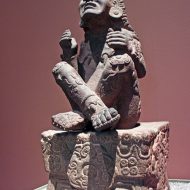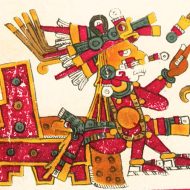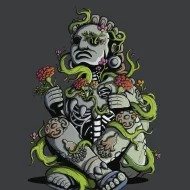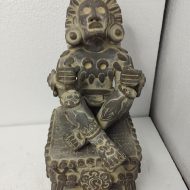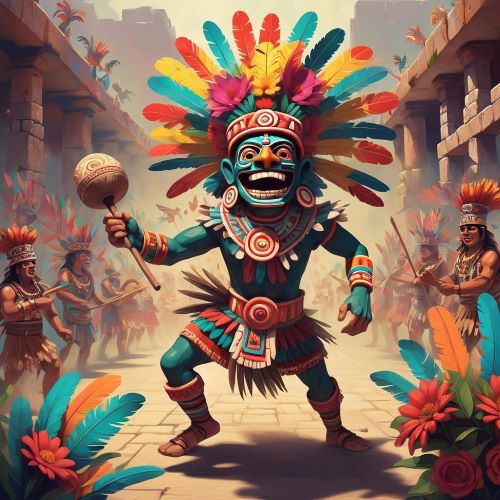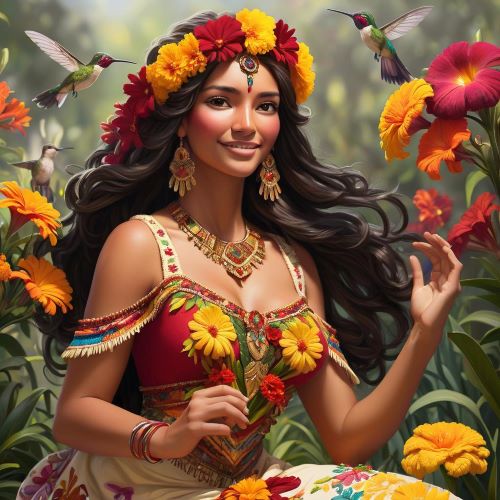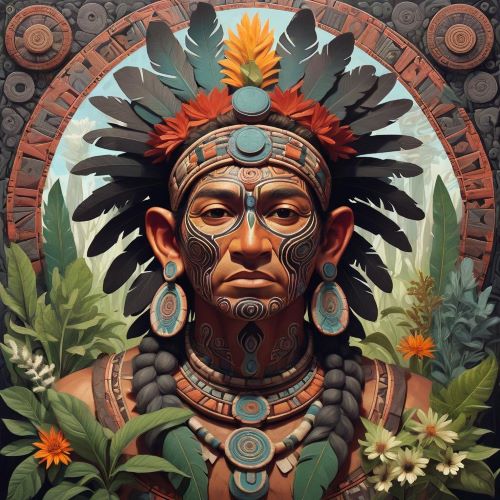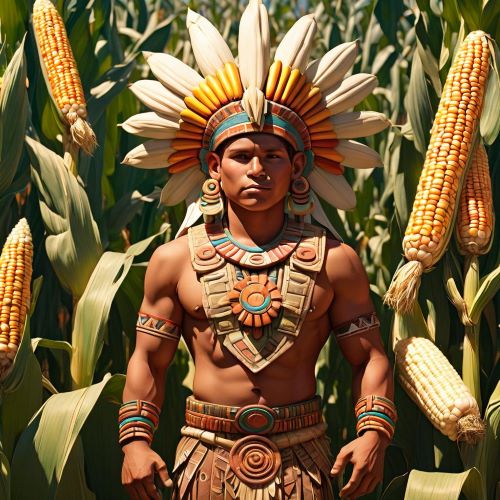Xochipilli : The Flower Prince
Listen
At a glance
| Description | |
|---|---|
| Origin | Aztec Mythology |
| Classification | Gods |
| Family Members | Tlazolteotl (Mother), Tonatiuh (Father), Ixtlilton, Macuilxochitl (Brothers), Xochiquetzal (Sister) |
| Region | Mexico |
| Associated With | Dance, Flowers, Abundance, Painting, Creativity |
Xochipilli
Introduction
Xochipilli, alternatively recognized as the ‘Flower Prince,’ holds a prominent role in Aztec mythology. As the deity presiding over art, games, dance, flowers, and song, he represents a departure from the stern and often bloodthirsty nature of his divine counterparts. His name derives from the Nahuatl words xōchitl (“flower”) and pilli (interpreted as either “prince” or “child”), thus encapsulating the essence of “flower prince.” In contrast to his more severe peers, Xochipilli’s dominion extends to realms characterized by laughter, music, and the intoxicating pleasures inherent in the tapestry of life.
Physical Traits
Xochipilli is frequently portrayed as a youthful figure adorned in distinctive regalia. His headdress, crafted from feathers, graces his head, and he is often depicted donning a mask while enveloped in flowers sourced from psychotropic plants and hallucinogenic mushrooms. Notably, he wears a talisman called an oyohualli, a teardrop-shaped pendant fashioned from mother-of-pearl. The vibrant imagery continues with his face painted in a radiant yellow hue, symbolizing the golden sun and the vibrancy of life.
Around his neck, Xochipilli wears a necklace fashioned from shells and jade, symbolically representing both the earthly bounty and the abundance of aquatic realms. Atop his head, a feathered headdress takes center stage, adorned with bells that resonate with each movement, echoing the joyful melodies he is associated with. However, perhaps his most distinctive feature is a wide, mischievous grin, reflecting his playful nature and deep affinity for life’s pleasures.
The iconography surrounding Xochipilli accentuates his strong association with pleasure and euphoria. Depictions of the deity often showcase him with a joyous countenance, engaging in activities such as playing musical instruments or participating in dance. This visual narrative underscores his pivotal role as a patron of the arts and revelry, symbolizing the exuberant celebration of life’s myriad joys.
Family
Within the realm of Aztec mythology, Xochipilli emerges as the offspring of the earth goddess Tlazolteotl and the sun god Tonatiuh. This divine lineage bestows upon him two brothers, Ixtlilton, presiding over health, medicine, and dancing, and Macuilxóchitl, the god overseeing games. Additionally, Xochipilli finds kinship with a sister or female counterpart in the form of Xochiquetzal. The interconnectedness of this divine family is a central theme, with Xochipilli seldom found in isolation.
Notably, Xochipilli shares a profound connection with his twin sister, Xochiquetzal, who holds sway over beauty, love, and fertility. Together, they embody the dual forces of life and growth, symbolizing the inseparable link between passion and creation. The familial ties extend further, often portraying Xochipilli in the company of Macuilxochitl, the playful god associated with games and gambling, and Ixtlilton, a benevolent deity governing healing and dance. This dynamic ensemble encapsulates the manifold facets of pleasure, ranging from the carefree delights of games to the profound satisfaction derived from artistic expression and the sensual pleasures entwined with love.
Other names
Beyond being known as the ‘Flower Prince,’ Xochipilli bears alternate titles that unveil distinct dimensions of his character. Referred to as Macuilxōchitl, signifying “Five-flower,” and Chicōmexōchitl, translating to “Seven-flower,” these names encapsulate varied aspects of his essence. Additionally, he is recognized as the ‘Príncipe de las Flores de Maíz,’ further enriching the tapestry of his identity.
Intriguingly, Chicomexōchitl, or “Seven-Flower,” spotlights Xochipilli’s patronage of artistic endeavors, specifically in the realms of writing and painting. Meanwhile, Macuilxōchitl, or “Five-Flower,” draws attention to his playful nature and association with games and festivities. Occasionally referred to as Tlalteotl, meaning “Earth Lord,” Xochipilli’s connection to the fertility and abundance of the natural world is underscored.
Each epithet harbors a unique revelation about the multifaceted God of Flowers, inviting exploration into the depth and richness of his domain. In certain instances, Xochipilli assumes a more abstract identity as “Axoqcoyotl,” denoting “The Lord of the Game,” signifying his sway over artistic and recreational pursuits. These alternative names contribute layers to his character, offering a nuanced portrayal that mirrors the diverse facets of his divine persona.
Powers and Abilities
Xochipilli’s influence extends far beyond the realm of brute force, manifesting in the enchantment he effortlessly weaves through his touch. Possessing the remarkable ability to kindle creativity, spark passion, and infuse hearts with unbridled joy, he governs the intoxicating realms of art, music, and dance. In his presence, mortals find themselves transported to dimensions of ecstatic bliss, captivated by the alluring magic he bestows.
Central to Xochipilli’s dominion is his unique connection to flowers and hallucinogenic plants, granting him the power to unlock concealed pathways of perception. In doing so, he reveals profound truths and inner landscapes, broadening the horizons of those touched by his divine influence. With a mischievous playfulness, Xochipilli possesses the ability to conjure laughter and dissolve tensions through lighthearted pranks. His true strength lies in the profound reminder he offers – that beauty and joy are inherent in every fleeting moment of life.
Revered as one of the Ahuiateteo, gods of excess, Xochipilli’s domain transcends mere mortal desires. He is intimately tied to dance, painting, creativity, and festivities, embodying the essence of indulgence. Xochipilli’s profound connection to the souls, fertility, and the abundance of nature symbolizes the intricate interdependence of life’s myriad facets. As a bestower of fertility, he oversees the procreation of new life and the flourishing growth of abundance, weaving a tapestry of vitality and interconnectedness within the fabric of existence.
Modern Day Influence
Despite the passage of centuries since the decline of the Aztec empire, Xochipilli’s influence persists, leaving an indelible mark on the contemporary world. Artists, musicians, and dancers draw inspiration from his playful spirit and boundless creative energy. Within LGBTQ+ communities, he is celebrated as a symbol of acceptance and diversity, his association with male partnerships and unconventional artistic expression challenging societal norms.
Environmentalists hold Xochipilli in high regard as a guardian of nature’s abundance, urging humanity to value and preserve the delicate balance of our planet. Through the prism of Xochipilli’s teachings, we discover the capacity to derive joy from ordinary moments, celebrate the inherent beauty of creation, and embrace the intoxicating power of human connection.
In today’s landscape, Xochipilli remains a significant figure in Mexican culture, frequently featured in contemporary art and literature. Some indigenous communities in Mexico continue to honor him through traditional ceremonies and festivals, emphasizing the enduring relevance of his influence in the tapestry of cultural practices.
Related Images
Frequently Asked Questions
What is lorem Ipsum?
I am text block. Click edit button to change this text. Lorem ipsum dolor sit amet, consectetur adipiscing elit. Ut elit tellus, luctus nec ullamcorper mattis, pulvinar dapibus leo.
What is lorem Ipsum?
I am text block. Click edit button to change this text. Lorem ipsum dolor sit amet, consectetur adipiscing elit. Ut elit tellus, luctus nec ullamcorper mattis, pulvinar dapibus leo.
What is lorem Ipsum?
I am text block. Click edit button to change this text. Lorem ipsum dolor sit amet, consectetur adipiscing elit. Ut elit tellus, luctus nec ullamcorper mattis, pulvinar dapibus leo.
What is lorem Ipsum?
I am text block. Click edit button to change this text. Lorem ipsum dolor sit amet, consectetur adipiscing elit. Ut elit tellus, luctus nec ullamcorper mattis, pulvinar dapibus leo.
What is lorem Ipsum?
I am text block. Click edit button to change this text. Lorem ipsum dolor sit amet, consectetur adipiscing elit. Ut elit tellus, luctus nec ullamcorper mattis, pulvinar dapibus leo.

